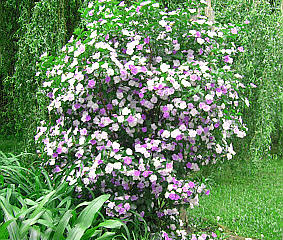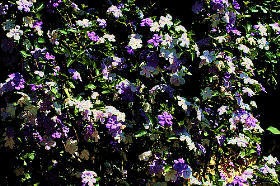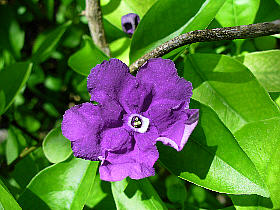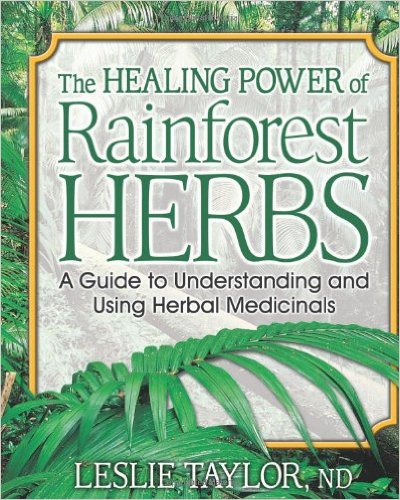Manaca is a scrubby tree that grows as much as 8 meters high. Duke
indicates that aside from B. uniflora
, other synonyms include:
B. mutabilis
, B. hopeana
.
It is not to be confused with its cousins, B. chiricaspi and B. grandiflora, both of
which are used in the rainforest as entheogenics, but have similar morphological characteristics.
Manaca is frequently found as a cultivated ornamental on account of its very fragrant,
pretty, white and purple flowers. It is also used to make perfumes.
Uses & Protocols

Manaca is widely used both internally and externally to
treat a wide variety of ailments, although when taken alone internally, extreme caution should
be used. (The potential for abuse is the reason we do not sell this herb as a "single.")
Taken in proper, therapeutic doses, South American herbalists have long used manaca to
stimulate the lymphatic system. It is also considered a excellent blood cleanser,
much like
Ajo Te, a diuretic, laxative, sweat promoter,
analgesic, and anti-inflammatory.
Warnings & Contraindications

Pregnant, lactating, or women seeking to conceive
should not use this plant. Contraindicated for those sensitive to salicylate, so if you have
a problem with aspirin, you should avoid using Manaca. Anyone taking monoamine oxidase (MAO)
should avoid unless under the direction of a trained practitioner. These precautions aside,
Manaca is safe to use at the proper dosages: "No health hazards are known in conjunction
with the proper administration of designed therapeutic dosages (of Manaca; Duke, p. 129.)"
Shelf-Life

Five years or more.
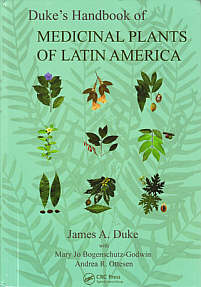
Medicinal Activities
 Further information for practitioners:
Further information for practitioners:
World-famous botanist Dr. James Duke attributes the following activities
to this plant
(p. 128-129; see hardcopy cover at right),
drawn from the extant literature. (See his graduation for "level of
efficacy" on our
amazon traditionals page;
followed by Duke's bibliographic abbreviations (in capital letters),
which we
identify
on a separate page.)

Duke provides a "
food farmacy potential" score for this
plant of "FNFF=X."
- Abortifacient (f; CRC)
- Alterative (f; CRC)
- Analgesic (1; X1842002)
- Anesthetic (f; CRC)
- Antiinflammatory (f1; CRC; X1842002; X895395)
- Antirheumatic (f; PH2)
- Antispasmodic (1; X11582535)
- Antivenom (snake) (f; X1842002)
- CNS-Depressant (1; X895395)
- Diaphoretic (f; CRC)
- Diuretic (f; CRC; PH2)
- Emmenagogue (f; CRC)
- Hypertensive (f; CRC)
- Hypothermic (f; CRC)
- Laxative (f; CRC)
- Lymphotonic (f; CRC)
- Narcotic (f; CRC)
- Poison (f; CRC)
- Purgative (f; CRC; HHB)
Indications
 Further information for practitioners:
Further information for practitioners:
Duke provides the following indications for this plant:
- Arthritis (f; CRC; HHB; PH2)
- Constipation (f; CRC)
- Cramps (1; X11582535)
- Dermatosis (f; CRC)
- Eczema (f; CRC)
- Fever (f; CRC)
- Inflammation (f1; CRC; X1842002; X895395)
- Low Blood Pressure (f; CRC)
- Lymph (f; CRC)
- Pain (f1; CRC; X1842002)
- Rheumatism (f; CRC; PH2)
- Scrofula (f; CRC; PH2)
- Snake Bite (f; X1842002)
- Spasms (1; X11582535)
- Syphilis (f; CRC; HHB; PH2)
- VD (f; PH2)
